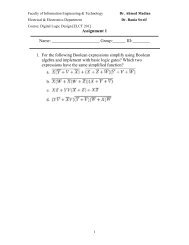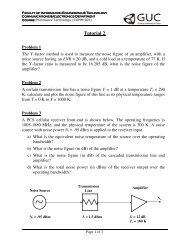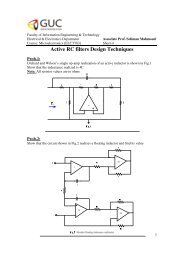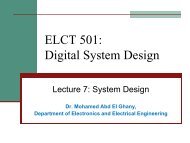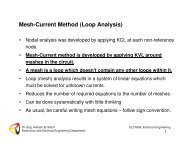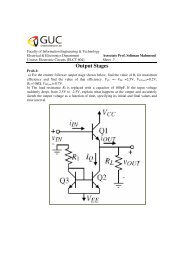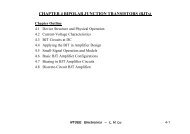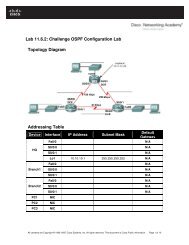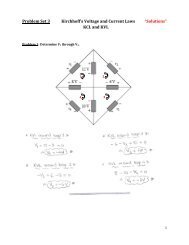Very Large Scale Integration (VLSI) - GUC - Faculty of Information ...
Very Large Scale Integration (VLSI) - GUC - Faculty of Information ...
Very Large Scale Integration (VLSI) - GUC - Faculty of Information ...
You also want an ePaper? Increase the reach of your titles
YUMPU automatically turns print PDFs into web optimized ePapers that Google loves.
<strong>Very</strong> <strong>Large</strong> <strong>Scale</strong> <strong>Integration</strong>(<strong>VLSI</strong>)Lecture 1Dr. Ahmed H. MadianAh_madian@hotmail.comDr. Ahmed H. Madian-<strong>VLSI</strong> 1
Course ObjectiveYou’ll get a bottom-up tour <strong>of</strong> how integrated circuits are engineered.We’ll talk about• MOSFETs: how they work, how they’re built, effects <strong>of</strong> newtechnologies• Various design and layout techniques, from the ordinary to themost complex, for creating combinational and sequential circuits,datapaths, memories, buffers, regular logic structures, …etc.• how you tackle the problem <strong>of</strong> designing circuits with 1,000,000gates -- you’re not in Digital IC Technique anymore!• Give different testing techniques for <strong>VLSI</strong> circuits.Dr. Ahmed H. Madian-<strong>VLSI</strong> 2
Administrative Rules• Course schedule:• Lectures:• Saturday (3 rd slot), 12:30 - 13:45• Tuesday (4 th slot), 14:15- 15:45• Office hours: Saturday 14:30 - 16:30 (C3.221)• Teaching assistant: Eng. Mona Guindy• Grading• Quizzes & Assignments: 20%• Assignment <strong>of</strong> every lecture is due the following lecture• Final exam: 80%Dr. Ahmed H. Madian-<strong>VLSI</strong> 3
References• Anantha Chandrakasan, William J. Bowhill, Frank Fox,“Deign <strong>of</strong> high performance microprocessor circuits”• John P. Uyemura, “Introduction to <strong>VLSI</strong> circuits andsystems”• Or any <strong>VLSI</strong> referencesDr. Ahmed H. Madian-<strong>VLSI</strong> 4
Course outline• Overview <strong>of</strong> <strong>VLSI</strong>• Technologies for Micro- and Nanostructures• Low-Voltage and power design• Synchronous and Asynchronous Circuit Design• Architectures for <strong>VLSI</strong> Applications• Test and Measurement Techniques for <strong>VLSI</strong>CircuitsDr. Ahmed H. Madian-<strong>VLSI</strong> 5
What is <strong>VLSI</strong>?• <strong>VLSI</strong> stands for (<strong>Very</strong> <strong>Large</strong> <strong>Scale</strong> Integratedcircuits)• Craver Mead <strong>of</strong> Caltech pioneered the filed <strong>of</strong> <strong>VLSI</strong>in the 1970’s.• Digital electronic integrated circuits could beviewed as a set <strong>of</strong> geometrical patterns on thesurface <strong>of</strong> a silicon chip.• Complexity could thus be dealt with using theconcept <strong>of</strong> repeated patterns that were fittedtogether in structured manner.Dr. Ahmed H. Madian-<strong>VLSI</strong> 6
<strong>VLSI</strong> History•Jack Kilby, working at Texas Instruments, first dreamed up the idea <strong>of</strong> amonolithic “integrated circuit” in July 1959. By the end <strong>of</strong> the year, he hadconstructed several examples, including the flip-flop shown in the patentdrawing above. Components are connected by hand-soldered wires andisolated by “shaping” and pn diodes used as resistors.Dr. Ahmed H. Madian-<strong>VLSI</strong> 7
<strong>VLSI</strong> History (cont.)• 1961: TI and Fairchild introduced the first logic IC’s (cost~$50 in quantity!). This is a dual flip-flop with 4 transistors.• 1963: Densities and yields are improving. This circuit hasfour flip flops.In 1970, making good on its promise to itsinvestors Intel starts selling a 1K bit RAM,the 1103.Dr. Ahmed H. Madian-<strong>VLSI</strong> 8
<strong>VLSI</strong> History (cont.)• Introduced in 1972, the 8008 had 3,500transistors supporting a byte-wide datapath. Despite its limitations, the 8008was the first microprocessor capable <strong>of</strong>playing the role <strong>of</strong> computer CPU asdemonstrated on the cover <strong>of</strong> the July‘74 issue <strong>of</strong> Radio-Electronics.Dr. Ahmed H. Madian-<strong>VLSI</strong> 9
Today• Many disciplines havecontributed to the current<strong>VLSI</strong> designs:• solid-state physics• materials science• lithography and fab• device modeling• architecture• algorithms• CAD tools• circuit design & layoutDr. Ahmed H. Madian-<strong>VLSI</strong> 10
Chip ComplexityChip classification according to number <strong>of</strong> active elements and minimal feature size:Dr. Ahmed H. Madian-<strong>VLSI</strong> 11
<strong>VLSI</strong> Chip Types• Full customEvery circuit is custom designed• Application-specific integrated circuits(ASICS) Design is created using astandard CAD tools without the need tointeract with the silicon structure• Semi-customIn between <strong>of</strong> full-custom and ASIC-typecircuits. The majority <strong>of</strong> the chip is designedusing a primitive predefined cells (standardcells) from library as building blocks.Dr. Ahmed H. Madian-<strong>VLSI</strong> 12
Top design levelSystem specificationsInitial conceptAbstract High-level modelVHDL, Verilog, HDLSystem designand verificationDesignhierarchyoverviewLogic synthesisCircuit designLogic designand verificationCMOS designand verificationbottom design levelphysical designSilicon logic designand verificationManufacturingMass production,testing andpackagingFinished <strong>VLSI</strong> chipMarketingDr. Ahmed H. Madian-<strong>VLSI</strong> 13
Top design levelSystem specificationsInitial conceptAbstract High-level modelVHDL, Verilog, HDLSystem designand verification<strong>VLSI</strong>Designbottom design levelLogic synthesisCircuit designphysical designLogic designand verificationCMOS designand verificationSilicon logic designand verificationManufacturingMass production,testing andpackagingFinished <strong>VLSI</strong> chipMarketingDr. Ahmed H. Madian-<strong>VLSI</strong> 14
<strong>VLSI</strong> ChallengesThe Moore’s Law (Moore is one <strong>of</strong> the co-founder <strong>of</strong> Intel corp.)has been fundamental to the silicon industry, obeyed for the past30 years; however, technology scaling will become difficultbeyond 0.18 micron, threatening Moore’s Law.Dr. Ahmed H. Madian-<strong>VLSI</strong> 15
<strong>Scale</strong>d-down TransistorsThe principle <strong>of</strong> constant-filedscaling lies in scaling the devicevoltages and the device dimensions(both horizontal and vertical) by thesame factor , k (>1) , such that theelectric filed remains unchanged.Dr. Ahmed H. Madian-<strong>VLSI</strong> 16
<strong>VLSI</strong> Challenges (cont.)Design Challenges <strong>of</strong> TechnologyScaling• Technology models 0.5µm, 0.35µm, 0.25µm,0.18µm, 0.13µm, 90nm, 65nm, 45nm, 32nm,20nm, ???.• Scaling factor <strong>of</strong> 0.7 in the dimension exist fromgeneration to the next one.• Scaling in Area = 0.7 X 0.7 = 0.490.5. This meansthe transistor density doubles every generation.Dr. Ahmed H. Madian-<strong>VLSI</strong> 17
Challenges <strong>of</strong> <strong>VLSI</strong> (cont.)Every Two years:1. Capacitance per node reduces by 30% (usual scaling)2. Electrical nodes in a given area increase by 2X3. Die size grows by 14% every two years (Moore’s Law)4. Supply voltage reduces by 15% every two years5. And frequency increases by 2X.• This all adds up to 2.7X increase in active power <strong>of</strong> thelead microprocessor every two years.Dr. Ahmed H. Madian-<strong>VLSI</strong> 18
Revision on MOSFETFabrication procedureDr. Ahmed H. Madian-<strong>VLSI</strong> 19
Building MOSFET• bulk CMOS with a p-type substrate:P-typeslice <strong>of</strong> a silicon ingot that has beendoped with an acceptor (typicallyboron) to increase the concentration <strong>of</strong>holesBack is metallized to providea good ground connection.Dr. Ahmed H. Madian-<strong>VLSI</strong> 20
Building MOSFET (cont.)• Next, a “thick” layer <strong>of</strong> silicon dioxide, called field oxide,is formed on the surface by oxidation in wet oxygen.This is then etched to expose surface where we want tomake a MOSFET:Dr. Ahmed H. Madian-<strong>VLSI</strong> 21
Building MOSFET (cont.)• Now grow a “thin” layer <strong>of</strong> silicon dioxide, calledgate oxide, on the surface by exposing the waferto dry oxygen.Dr. Ahmed H. Madian-<strong>VLSI</strong> 22
Building MOSFET (cont.)• On top <strong>of</strong> the thin oxide a thick layer <strong>of</strong> polycrystalline silicon,called polysilicon or poly for short, is deposited by CVD. Thepoly layer is patterned and plasma etched exposing thesurface where the source and drain junctions will be formedDr. Ahmed H. Madian-<strong>VLSI</strong> 23
Building MOSFET (cont.)• The entire surface is doped, either by diffusion or ionimplantation, with phosphorus (an electron donor) whichcreates two n-type regions in the substrate. The phosphorusalso penetrates the poly reducing its resistance and affectingthe nfet’s threshold.n+ n+Dr. Ahmed H. Madian-<strong>VLSI</strong> 24
Building MOSFET (cont.)• Finally an intermediate oxide layer is grown andthen reflowed to flatten its surface. Holes areetched in the oxide (where contacts to poly/diffare wanted) and aluminum deposited, patternedand etched.n+ n+Dr. Ahmed H. Madian-<strong>VLSI</strong> 25
Threshold voltage• The gate voltage required to form the channel is called thethreshold voltage. Many factors affect the gate-source voltage atwhich the channel becomes conductive. Threshold voltage forsource-bulk voltage zero:VTo 2GCFQCboxQCAs V sb increases, the depth <strong>of</strong> the depletion region increases, exposing more<strong>of</strong> the fixed acceptor (i.e. negative) ions in the substrate.VT Vtno VsB 2 2where FFoxox2qNWhere F is the Fermi potential, Q b is the depletion region charge, is thesubstrate coefficient and V SB is the substrate bias voltageDr. Ahmed H. Madian-<strong>VLSI</strong> 26siCoxA
Channel-Length modulationDr. Ahmed H. Madian-<strong>VLSI</strong> 27
SPICE Models• There are different models used in circuitsimulators:• level 1 is our simple model including the mostimportant second order effects described• level 2 model is based on device physics• level 3 is a semi-empirical model allowing tomatch equations to the real circuit: exampleBSIM model from Berkeley modelssubthreshold characteristics.Dr. Ahmed H. Madian-<strong>VLSI</strong> 28
Physical design• CMOS ICs are electronic switchingnetworks that are created on small area <strong>of</strong>silicon wafer using complex set <strong>of</strong> physicaland chemical processes.• A primary task for <strong>VLSI</strong> designer is totranslate circuit schematics into siliconform (this process is called physical design)Dr. Ahmed H. Madian-<strong>VLSI</strong> 29
Integrated Circuit Layers• ICs are made bystacking different layers<strong>of</strong> materials in a specificorder to form threedimensional structuresthat act as an electronicswitching network.Layer M1InsulatorSubstrateSubstrateM1M1Side viewTop viewDr. Ahmed H. Madian-<strong>VLSI</strong> 30
Integrated Circuit Layers (cont.)Layer M2Layer M1insulatorLayer M1SubstrateLayer M2Side viewTop viewDr. Ahmed H. Madian-<strong>VLSI</strong> 31
Designing NFET Arrays layout• Devices can sharepatterned regions,which may reducethe layout area orcomplexityA B Cn+ n+ n+ n+ n+ n+n+ n+ n+ n+A B CDr. Ahmed H. Madian-<strong>VLSI</strong> 32
Designing PFET Arrays layout• Devices can sharepatterned regions,which may reducethe layout area orcomplexityA B Cp+ p+ p+ p+ p+ p+N-wellp+ p+ p+ p+A B CDr. Ahmed H. Madian-<strong>VLSI</strong> 33
Design Examples <strong>VLSI</strong>• Draw the CMOS realization and thelayout <strong>of</strong> NAND and NOR gates• Colors <strong>of</strong> layerspolysilicon (gates): RedDoped n+/p+ (active) : GreenN-Well : YellowMetal 1: BLUEMetal 2 : GreyContacts: Black X’sDr. Ahmed H. Madian-<strong>VLSI</strong> 34
CMOS RealizationV DDV DDaF a.bbaF a bbNAND gate CMOS realizationNOR gate CMOS realizationDr. Ahmed H. Madian-<strong>VLSI</strong> 35
NAND FET LayoutPFETN-WELLP+ Gate P+Gate P+aV DDbNFETN+ Gate N+ Gate N+Dr. Ahmed H. Madian-<strong>VLSI</strong> 36
NAND FET Layout (cont.)V DDX XV DDPFETabNFETXGNDDr. Ahmed H. Madian-<strong>VLSI</strong> 37
NAND FET Layout (cont.)V DDV DDPFETXXXOUTabNFETGNDXabXDr. Ahmed H. Madian-<strong>VLSI</strong> 38
NOR FET layoutV DDV DDPFETXXOUTabNFETGNDXaXbXDr. Ahmed H. Madian-<strong>VLSI</strong> 39
Design Examples <strong>VLSI</strong>• Draw the pass transistor realizationand the layout <strong>of</strong> MUX 4:1• Colors <strong>of</strong> layerspolysilicon (gates): RedDoped n+/p+ (active) : GreenN-Well : YellowMetal 1: BLUEMetal 2 : GreyContacts: Black X’sDr. Ahmed H. Madian-<strong>VLSI</strong> 40
CMOS realization <strong>of</strong> MUX 4:1S1 S1 S0 S0P0P0P1P2P3MUX4:1FP1FS0S1P2P3Dr. Ahmed H. Madian-<strong>VLSI</strong> 41
MUX layoutS1S1S0S0S1 S1 S0 S0P0XXXXP0P1XXXFP1FP2XXXXP2P3XXXP3Dr. Ahmed H. Madian-<strong>VLSI</strong> 42
Design Examples <strong>VLSI</strong>• Draw the CMOS realization and the layout <strong>of</strong>logic function• Colors <strong>of</strong> layerspolysilicon (gates): RedDoped n+/p+ (active) : GreenN-Well : YellowMetal 1: BLUEMetal 2 : GreyContactsf a b.c: Black X’sDr. Ahmed H. Madian-<strong>VLSI</strong> 43
CMOS RealizationV DDbcafbacDr. Ahmed H. Madian-<strong>VLSI</strong> 44
Logic function LayoutV DDN-WellPFETP+bcafbaNFETN+cDr. Ahmed H. Madian-<strong>VLSI</strong> 45
Logic function LayoutV DDPFETN-WellXcV DDXbXabcafNFETabcDr. Ahmed H. Madian-<strong>VLSI</strong> 46
Logic function LayoutV DDPFETN-WellXcV DDXbXaXbcaffbaNFETXXXcGNDDr. Ahmed H. Madian-<strong>VLSI</strong> 47
Layout Rules• Layout rules are the common language between design andprocess engineers• conservative rules absorb process disturbances and variations• layout rules must be respected by the designer• layout rules reflect the limits <strong>of</strong> a process, they describe:• minimal distance, overlap• minimal width (e.x. channel length, λ)• layout readability is improved using colors:• metal blue• polysilicium red• n-diffusion green• p-diffusion yellow• n-well brown• contact, via blackDr. Ahmed H. Madian-<strong>VLSI</strong> 48
LayoutDr. Ahmed H. Madian-<strong>VLSI</strong> 49
Stick Diagram• stick diagrams aretechnology independent• no layout rules need tobe known• mask layout may begenerated automaticallyDr. Ahmed H. Madian-<strong>VLSI</strong> 50
Digital Layout: horizontal or verticalgates?• Vertical gates• Good for circuits where fetssizes are similar and eachgate has limited fanout. Bestchoice for multiple input staticgates and for datapaths.• Horizontal gates• Good for circuits where long and shortfets are needed or where nodes mustcontrol many fets. Often used inmultiple-output complex gates (e.g,sum/carry circuits).Dr. Ahmed H. Madian-<strong>VLSI</strong> 51
Eliminating GapsDr. Ahmed H. Madian-<strong>VLSI</strong> 52
Complex CMOS Gates compactlayout.• Euler Rule:• Generate an n-graph by replacing the nfet blockwith vertices for nodes and edges for fets• Generate a dual p-graph• Find a sequence containing all edges in the n-graph. This sequence is called Euler n-path.• Generate an Euler p-path with the same labelingas the Euler n-path. If not possible start again.• The labeling sequence <strong>of</strong> the 2 Euler paths are thegate sequence <strong>of</strong> the single row nfet/pfet CMOSgate.Dr. Ahmed H. Madian-<strong>VLSI</strong> 53
Example• Draw the most compact layout for thefollowing logic function using Euler’s rule.F= A.(B+C)Dr. Ahmed H. Madian-<strong>VLSI</strong> 54
SolutionV DDAFCAN1BAN2FV DDCN2N1BFCBGNDGNDA B CDr. Ahmed H. Madian-<strong>VLSI</strong> 55
Layout <strong>of</strong> ExampleA B CA B CDr. Ahmed H. Madian-<strong>VLSI</strong> 56
Thanks• Revision sheet will be soon available onthe web site• you must solve it• Download one <strong>of</strong> the layout tools andpractice on the lecture examplesDr. Ahmed H. Madian-<strong>VLSI</strong> 57




